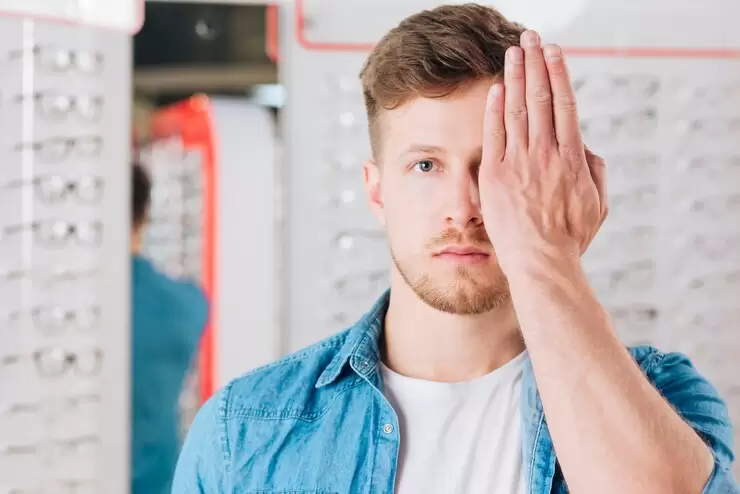
Entropion is an eye disease caused by the eyelashes touching the front surface of the eye as a result of the eyelid turning inward. This can cause permanent damage to the cornea and conjunctiva (outer layer of the eye). If left untreated, this disorder can lead to more serious eye problems, or even vision loss.
The main causes of entropion can be due to various factors. This includes the following reasons:
Aging: The most common cause is the loss of elasticity of the eyelids due to aging. The muscles around the eyes weaken and can cause the lids to turn inward.
Injuries: Damage to the tissues around the eyes or scars from previous surgeries can disrupt the normal position of the eyelids.
Genetic factors: Some people may be genetically predisposed to entropion. In particular, cases of congenital entropion can be seen in children.
Infections and inflammations: Chronic infections or inflammatory conditions of the eye can cause changes in the eyelids.
Neurological problems: In cases such as nerve damage or paralysis, loss of control of the eyelid muscles leads to entropion.
There are some typical signs to look out for to identify entropion:
Eye redness and inflammation: Eyelashes touching the front surface of the eye causes irritation and redness.
Pain and burning sensation: As a result of contact of the eyelid and eyelashes with the cornea, there is a constant discomfort and burning sensation.
Tearing: As a natural protection mechanism of the eye, tear production increases.
Blurred vision: As the eye is constantly irritated, vision can also be affected.
Risk of infection: Eye irritation and damage can lead to infections.
Entropion occurs for various reasons and there are different types of entropion:
Age-related entropion: This is the most common type and is caused by the weakening of the eyelid muscles due to aging.
Entropion due to scarring (scar tissue): Scarring in the skin and tissues around the eye can cause the eyelid to misalign. It can be caused by injuries, surgeries or inflammatory diseases.
Congenital entropion: Some babies are born with entropion as a result of improperly formed eyelids at birth. This condition is detected and treated soon after birth.
Spastic entropion: This type of entropion occurs due to spasms of the eyelid muscles, causing the eyelid to rapidly roll inward. Basically, irritation or inflammation of the eye causes these spasms.
If left untreated, entropion can cause a number of serious complications:
Damage to the cornea: The constant rubbing of the eyelashes on the cornea can damage it and even cause an ulcer. This can lead to serious vision problems.
Chronic eye infections: Continuous irritation of the eye creates a favorable environment for infections. These infections can last for a long time and are difficult to treat.
Dry eye syndrome: Constant stimulation of tear glands can lead to dry eye problem, which weakens the eye's defense mechanism.
Ophthalmologists use several diagnostic methods to determine entropion:
Eye examination: The doctor examines the condition of the eyelids, the surface of the eye and the cornea.
Imaging in suspected cases: In rare cases, MRI or other imaging techniques may be used to better investigate trauma or neurological causes.
Treatment of entropion is carried out more effectively with modern surgical methods:
Minimally invasive surgery: Minimally invasive techniques that cause less trauma are used for entropion surgery. This results in faster recovery and fewer complications.
Laser technologies: Laser removal of scar tissue and repositioning of the eyelid are among the modern technologies.
Bionic eye muscles: Research continues on special bionic implants that strengthen eye muscles and correct lid movement.
Eye massage and gymnastics: Special exercises and massage techniques to strengthen the eyelid muscles can be helpful in the early stages of entropion.
Anti-inflammatory herbal remedies: Certain herbal ointments and eye washes can be used under a doctor's supervision to reduce eye inflammation.
Paying attention to eye hygiene is important to prevent eye diseases.
Regular eye examinations are necessary for early detection of the disease.
Avoiding eye trauma reduces the risk of damage to eye tissues.
Protect your eyes from irritants: Avoid dust, chemicals and allergens that can increase eye infections or irritation.
Massage the eyelid regularly: Regular eye massage to help keep the eyelid in an outward position can bring relief.
Get regular eye care: Stay in touch with your ophthalmologist to protect your eye health and prevent the condition from progressing.
2024-07-17
2024-02-14
2024-02-14
2024-06-12
2024-06-13
2024-06-13
2024-06-13
2024-06-14
2024-06-14
2024-06-14
2024-06-14
2024-06-14
2024-06-14
2024-06-14
2024-07-31
2024-07-31
2024-07-31
2024-07-31
2024-08-09
2024-08-12
2024-08-28
2024-09-05
2024-09-06
2024-09-14
2024-09-19
2024-09-19
2024-10-02
2024-10-07
2024-10-21
2024-10-23
2024-10-29
2024-11-12
2024-11-18
2024-11-21
2024-11-26
2024-11-28
2024-12-03
2024-12-06
2024-12-10